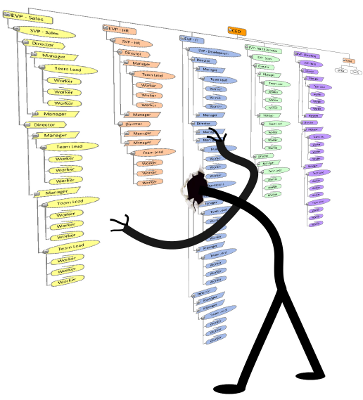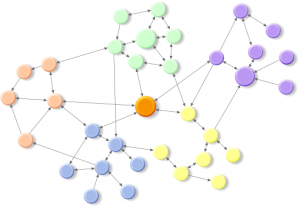The most common maps of enterprises are hierarchical “organizational charts”. We see them everywhere. We depend on them to illustrate the structural elements of an organization and identify the people working within them. Their underlying organizing principle is top-down granting of authority.
Getting work done in organizations depends on relationships that traverse these artificial boundaries. Collaboration and “cross-functional” teams are a necessary feature of organizational life.
“… understanding how networks work is an essential 21st century literacy.” — Howard Reingold
A critical element of successful communication is knowing your audience. If you need to communicate important information and you’re relying solely on the corporate hierarchy to cascade it from the top, with the attention it deserves, I’d urge you to reconsider. Working with key influencers to craft “viral” messages can have far greater impact. Critical change initiatives need support from critical people. If you can’t identify them you’re flying blind.
The map is not the territory
 If you think your organizational chart represents the relationships that get work done you need to pull your head out the sand (or the chart).
If you think your organizational chart represents the relationships that get work done you need to pull your head out the sand (or the chart).
It’s amazing how much attention is paid to the hierarchy documented in the organizational chart. All of us, when asked, will freely admit that the relationships required to get work done are not illustrated by an org chart.
The reality of the modern organization is that it’s a network. It is the sum of social and working relationships that traverse both organizational silos and levels. The “old boys’ club”, the grapevine, even the smoker’s huddle indicate networks that use informal paths of communication to share trust, knowledge and support.
Organizational Network Analysis
Adopting a network view  is much more useful when it comes to understanding connections between people in organizations. We’re social and form relationships of commitment and trust we need to achieve both personal and corporate goals. This mesh of personal interaction isn’t revealed by an organizational chart but exists nonetheless.
is much more useful when it comes to understanding connections between people in organizations. We’re social and form relationships of commitment and trust we need to achieve both personal and corporate goals. This mesh of personal interaction isn’t revealed by an organizational chart but exists nonetheless.
Working with key or central people within these networks can amplify communication efforts, accelerate change and identify opportunities to promote development. If only we could identify them.
Making invisible connections visible
Tools and processes to do just that are readily available – Organizational Network Analysis or ONA. This type of analysis isn’t a new idea. It’s been used since the 1950s. Pioneers and advocates in the field like Valdis Krebs , Rob Cross and Patti Anklam, among others, have a significant body of experience in making invisible organizational links visible. Growing awareness and analysis of network dynamics has been sparked by internet communities like Facebook and LinkedIn. In parallel, Organizational Network Analysis adoption is finding new advocates. And new providers of tools, analytic software and services like Netview and Keyhubs are emerging.
This is an important and useful tool to consider when thinking about how to make your organizational development or communication initiatives work best.
